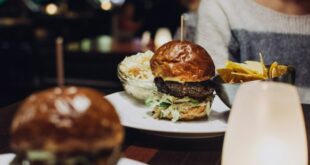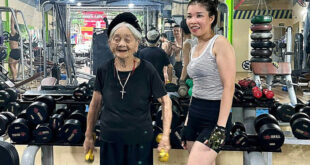Several times a week, Brooklyn’s “heart pounds and legs shake” as her Vietnamese husband teaches her to ride a motorcycle in an empty lot in Nam Tu Liem district.
“I believe that knowing how to ride a motorcycle and speak Vietnamese are two keys to surviving in Vietnam,” says 24-year-old Brooklyn, who used to work as a nurse in St. Louis.
But traversing Hanoi’s bustling streets via motorcycle and learning Vietnamese haven’t been totally seamless experiences for the American woman as she transitions into her new life as the daughter-in-law of a Vietnamese family.
Brooklyn met Van Tan Vu, a Hanoi native who works in education, during a group outing in the U.S. in 2020. They quickly developed a mutual admiration: Brooklyn was gentle and insightful, while Vu was a strong, direct man who had been studying abroad since he was 16.
Two years later, she moved by chance to the building where Vu lived. They began to see each other more frequently and started inquiring about each other’s daily lives.
“At first, I didn’t know much about Vietnam beyond the war I had studied,” Brooklyn said. “But Vu told me so much about his homeland.”
Their first official date was at a Vietnamese restaurant. Although the food wasn’t particularly authentic, it offered Brooklyn her initial taste of Vietnamese cuisine. She enjoyed bun cha (rice noodles with grilled pork), pho, and banh mi.
Over the time, Vu’s stories about Vietnam painted a picture of a country where community is central—where families, neighbors, and villages support one another—in Brooklyn’s head. The warmth of the Vietnamese culture Vu described, unlike the independent, individualistic lifestyle in America, is part of what inspired Brooklyn to make a long-term commitment: she and Vu got married in St. Louis in January this year.
 |
|
Brooklyn (R), originally from the U.S., and her Vietnamese husband Van Tuan Vu, at their wedding in January, 2024. Photo courtesy of Brooklyn and Vu |
‘Homeward’ bound
After reaching several significant life milestones—graduating, working, and marrying—Vu started thinking more about his homeland, especially since his parents were getting older.
“I’ve been away for quite some time and think it’s the right time to be near my parents,” he said.
His wife understood. The couple began planning their move to Vietnam two months later, after Brooklyn completed her nursing degree.
By the end of April, Brooklyn arrived at Hanoi’s Noi Bai airport, where she was initially shocked by the traffic and climate. The summer heat, coupled with high humidity, kept her constantly sweating. She was also startled by the sight of a small boy cycling among cars and motorcycles during her first days in the country.
“I was scared for the boy but realized that here, everyone is just used to it,” she said.
Vu’s family welcomed her warmly and with friendliness. However, Brooklyn felt shy because she couldn’t initiate anything without her husband’s presence due to the language barrier and her inability to ride a motorcycle.
“I realized I wanted to learn how to become Vietnamese,” she said.
Upon learning his wife’s intention, Vu gifted her a small notebook to journal her daily feelings as a way of supporting her. He also committed to helping Brooklyn adapt to local culture.
 |
|
Brooklyn and Vu in Hanoi, June 2024. Photo courtesy of Brooklyn and Vu |
‘Full of activity’
Initially, Brooklyn observed Vietnamese life, noting that people are industrious, skillful, and hardworking. She once saw a woman carrying a large bag of trash on a small motorcycle and thought that an American “might have given up from the start.”
She noted that young Vietnamese also tended to work almost continuously, often bringing work home after office hours – something she said she had rarely seen in American offices.
Brooklyn started going out more in the evenings and fell in love with the hustle and bustle of Hanoi’s nightlife, where culture buzzed until the early morning. Her neighborhood in the U.S. had been often quiet by 8 p.m., with its shops closed and streets deserted. But in Hanoi, stores remained open, and people continued to chat, exercise, and sit in cafés.
“Life is full of activity, and people like to do everything together,” she observed.
Brooklyn motivated herself to learn Vietnamese, with her husband guiding her a few times a week. Initially, she described feeling lost in a “maze” of sounds and diacritic marks. For instance, words like “ca,” “cá,” “cà,” “cả,” and “cạ” all have different meanings and are said in different ways that Americans find hard to distinguish at first.
But the language’s most difficult aspect for Brooklyn was the variety of Vietnamese pronouns, which vary based on gender, age, or social relationship. She attempted to memorize a few and practiced them when dining out. Even with her husband, she tried simple Vietnamese sentences to order food.
“I feel very happy if they understand anything I say,” she said.
She also seized every opportunity to practice the language, such as counting in Vietnamese in her head while waiting at red lights.
Another thing Brooklyn learned was the warmth of Vietnamese women like Vu’s mother, who would wash her children’s clothes or wait for Brooklyn with a hot bowl of pho when she came home late. This differed from American culture, where when Brooklyn and Vu returned home at midnight, they found that everyone had already gone to bed, with food left cold in the kitchen and greetings reserved for the next morning.
The American woman came to appreciate that meals serve as a connection point for Vietnamese families, and she and her husband tried to always have dinner with his parents every evening. After each meal, she also volunteered to help wash the dishes.
Cross-cultural traffic
However, her greatest challenge remained adapting to the traffic. Vu once let her experience a traffic jam by intentionally driving onto a main road during rush hour. She had to become accustomed to the sounds of horns and the flow of moving vehicles.
Brooklyn began learning to ride a motorcycle by balancing with both feet and then gradually accelerating. She also practiced using the rear-view mirrors and monitoring the vehicles beside her to avoid collisions.
“My skills are still not good, and I have to practice a lot,” she said.
One late June night, Brooklyn sat by a window writing in the journal Vu had gifted her. She described her two months in Vietnam as opening a new chapter in her life with much to learn each day.
“When we have children, we want them to grow up with Vietnamese culture and language,” Vu said about the newlyweds’ future plans. “No matter where we live, they will remember their family roots.”
- Reduce Hair Loss with PURA D’OR Gold Label Shampoo
- Castor Oil Has Made a “Huge” Difference With Hair and Brow Growth
- Excessive hair loss in men: Signs of illness that cannot be subjective
- Dịch Vụ SEO Website ở Los Angeles, CA: đưa trang web doanh nghiệp bạn lên top Google
- Nails Salon Sierra Madre
 VnExpress News The News Gateway of Vietnam
VnExpress News The News Gateway of Vietnam





